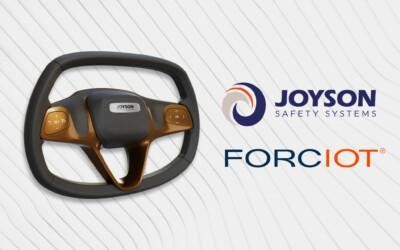Advanced Driver Assistance Systems (ADAS) represent a significant leap forward in automotive technology, changing the way we drive and enhancing overall safety on the roads. ADAS comprises a range of integrated technologies and features designed to assist drivers in various aspects of their driving experience.

Starting from level 2 of ADAS, the systems need to have a way to confirm the driver’s deliberate responsiveness via a performed maneuver or series of maneuvers. Hands-on detection (HOD) function is one way to meet this requirement.

Hands-on Detection (HOD)
HOD is mandated particularly in vehicles with advanced driver assistance systems (ADAS). In these systems, the steering wheel is equipped with HOD sensors that can detect when the driver’s hands are not on the wheel, even for a brief period. Forciot’s HOD technology can also detect whether the driver is firmly gripping the steering wheel or only touching it lightly or not at all.
As the growth in ADAS means more safety measures are required by regulators, the purpose of HOD in the steering wheel of a car is to ensure that the driver is paying attention and is ready to take control of the vehicle at any moment. When the HOD sensors detect that the driver’s hands are not on the wheel, or in more advanced sensing systems, the hands are not gripping the steering wheel firmly enough, the system may issue an indication to remind the driver to keep their hands on safe manner on the wheel.
FORCIOT® printed stretchable electronics technology provides a highly reliable and stretchable capacitive-based sensor solution integrated into the steering wheel. The system can detect touch and force, measuring accurately from gentle touch to firm grip force on the steering wheels. Additionally, the sensor can be placed close to the surface of the steering wheels, thus improving sensitivity and accuracy, and increasing safety for ADAS in cars. Another advantage of capacitive-based sensing using printed stretchable electronics is the enablement of multi-zone HOD, which allows detailed assessment of driving or driver status.
A key safety point in ADAS is frequent monitoring of the driver’s engagement with the driving task and confirming that the driver retains full responsibility. HOD and related advanced sensing technologies help to solve the question in a simple, cost-effective way. The level of force and grip applied on the steering wheel can be measured and analyzed in real-time to reflect the driver’s cognitive status and perception capabilities. Because HOD takes touch and grip force measurements directly from the driver’s hands instead of observing and giving assumptions about whether the hands are on the steering wheel, it provides prompt system responsiveness. Especially when the driver is required to engage with the driving task safely or make tactical driving decisions (e.g., choice of actions or path) in a timely manner, reliable measurements play an important role in road safety.
Into the future
There are great opportunities for further development in the steering wheel’s HOD in the future. With printed stretchable electronics, the printed heater and printed sensor can be enabled in the same structure. This reduces the thickness of the steering wheel and allows the sensor/heater to be placed closer to the steering wheel’s surface, improving the accuracy and efficiency of both the HOD system and heating functionalities. FORCIOT® GRIP works consistently even with gloves on.
With the status of current autonomous driving development, HOD in the steering wheel is an important safety feature. By ensuring that the driver is paying attention and is ready to take control of the vehicle, the system can help prevent accidents caused by driver distraction or inattention and keep the occupants of the vehicle safe.
Read more about Forciot’s solutions for the steering wheel here.




